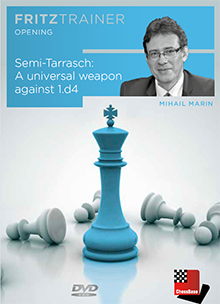Semi-Tarrasch: A universal weapon against 1.d4!
Great players like Fischer, Korchnoi and Kramnik have included the Semi-Tarrasch in their repertoire, which strongly speaks about its safe character and Black’s possibilities for counterplay. How useful is the Semi-Tarrasch in your games? The presenter is Romanian grandmaster Mihail Marin. The author presents a complete Semi-Tarrasch repertoire for Black, explaining the main strategic ideas of the resulting structures and providing complete analysis against practically all White's important variations.
Semi-Tarrasch: A universal weapon against 1.d4!
Throughout the history, great players like Fischer, Korchnoi and Kramnik have included the Semi-Tarrasch in their repertoire, which strongly speaks about its safe character and Black’s possibilities for counterplay. Fischer, for example, tried the Semi-Tarrasch in his ninth game against Spassky in the famous World Championship of 1972. He was able to equalize and comfortably draw the game.
The Semi-Tarrasch cannot offer a complete repertoire against 1.d4, being conditioned of White’s move order, it is an excellent complement to the Nimzoindian Defence. Moreover, it is a viable way of escaping the strategic pressure in the Exchange Queen’s Gambit while also presenting a reliable weapon against the main Symmetrical English systems.
How useful is the Semi-Tarrasch in your games? If you are a Nimzoindian player, you may admit that after 1.d4 Nf6 2.c4 e6 3.Nf3 often gives you positions you aren't always prepared for. If you are a Queen's gambit player, the opponent can put pressure on you by using the now-popular Bf4 systems. Let GM Mihail Marin show you how he plans to deal with such branches:
Let us have a look at some of the games from the variation:
[Site "Germany"]
[Date "2012.11.10"]
[Round "3.4"]
[White "Nyback, Tomi"]
[Black "Naiditsch, Arkadij"]
[Result "0-1"]
[ECO "D41"]
[WhiteElo "2598"]
[BlackElo "2704"]
[PlyCount "86"]
[EventDate "2012.10.20"]
[EventType "tourn"]
[EventRounds "15"]
[EventCountry "GER"]
[Source "ChessBase"]
[SourceDate "2012.11.13"]
[WhiteTeam "Werder Bremen"]
[BlackTeam "Baden-Baden"]
[WhiteTeamCountry "GER"]
[BlackTeamCountry "GER"]
cxd4 Bb4+ 9. Bd2 Bxd2+ 10. Qxd2 O-O 11. Bc4 Nd7 12. O-O b6 13. d5 Nc5 14. Rad1
Qf6 15. Qe3 e5 16. Nd2 Bd7 17. f4 Rac8 18. Rde1 b5 19. fxe5 Qxe5 20. Bb3 f6 21.
Nf3 Qd6 22. e5 fxe5 23. Qxe5 Rf6 24. Bc2 Rcf8 25. Qxd6 Rxd6 26. Ng5 Rxf1+ 27.
Rxf1 g6 28. Ne4 Nxe4 29. Bxe4 Kg7 30. Kf2 Ra6 31. Ke3 Rxa2 32. Kd4 b4 33. d6
Rd2+ 34. Kc5 b3 35. Ra1 Ra2 36. Rb1 Ra5+ 37. Kd4 Rb5 38. Bd5 b2 39. Bc4 Rb6 40.
Kc3 Kf6 41. Bb3 Be6 42. Rf1+ Kg7 43. Bc2 Rxd6 0-1

Vladimir Kramnik pulled off an important victory over Levon Aronian in the Candidates 2013. The game started as a Semi-Tarrasch, with both players choosing sensible plans and sequences. The first sign of willingness to break from the status quo was the lone 13…b5 by Vladimir Kramnik, an aggressive and unorthodox way to prevent Bc4 from attacking his queen on d5. This seemed to destabilize the great Armenian player, and Levon Aronian began to lose his way in the highly complex middlegame that ensued.
[Site "London ENG"]
[Date "2013.03.29"]
[Round "12"]
[White "Levon Aronian"]
[Black "Vladimir Kramnik"]
[Result "0-1"]
[ECO "D42"]
[WhiteElo "2809"]
[BlackElo "2810"]
[PlyCount "124"]
[EventDate "2013.03.15"]
O-O 9. Qc2 cxd4 10. exd4 f5 11. O-O Bf6 12. Nxd5 Qxd5 13. Be3 b5 14. Qe2 Bb7
15. Rac1 a6 16. Rfd1 f4 17. Rc5 Qd6 18. Qc2 fxe3 19. Bxh7+ Kh8 20. fxe3 Ne7 21.
e4 Rac8 22. e5 Bxe5 23. Nxe5 Rxc5 24. Ng6+ Nxg6 25. dxc5 Be4 26. Rxd6 Bxc2 27.
Bxg6 Bxg6 28. Rxe6 Bd3 29. h4 a5 30. c6 Rf1+ 31. Kh2 Rc1 32. Re3 Bb1 33. Rc3
Rxc3 34. bxc3 Kg8 35. c7 Bf5 36. Kg3 Kf7 37. Kf4 Bc8 38. Kg5 Bd7 39. h5 Be6 40.
g3 a4 41. g4 Kf8 42. Kf4 Ke7 43. g5 Kd7 44. Ke5 Bg8 45. c8=Q+ Kxc8 46. Kd6 Kd8
47. Kc6 Ke7 48. Kxb5 Ke6 49. Kxa4 Kf5 50. g6 Kg5 51. Kb5 Kxh5 52. a4 Kxg6 53.
a5 Kf6 54. a6 Bd5 55. c4 Ba8 56. Kb6 Ke5 57. Kc7 g5 58. Kb8 Be4 59. Kc7 g4 60.
a7 g3 61. c5 Ba8 62. Kb8 Bc6 0-1


The presenter is Romanian grandmaster Mihail Marin. He has won the Romanian championship multiple times and played in eleven chess Olympiads. Marin possesses a rare gift for a grandmaster – he is able to explain in readily comprehensible terms the ideas behind moves, variations, and positions. This ability is there for all to admire in his contributions to ChessBase Magazine.

The author presents a complete Semi-Tarrasch repertoire for Black, explaining the main strategic ideas of the resulting structures and providing complete analysis against practically all White's important variations.
- Video running time: 6 hours 10 min. (English)
- With interactive training including video feedback
- Extra: Database with more than 50 instructive games
- Including CB 12 – Reader
This DVD (soft copy) is available for just Rs.999/- on the ChessBase India website for Indian residents. All you have to do is write an email to us at chessbaseindia@gmail.com.
These are original ChessBase products which are available at almost 60% discount to Indian residents because ChessBase India has tied up with the ChessBase headquarters in Hamburg. Soon our online shop will begin. Until then you can buy the products by writing to us at chessbaseindia@gmail.com.

